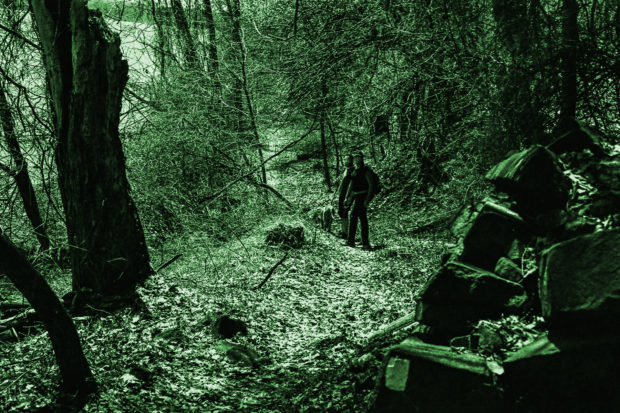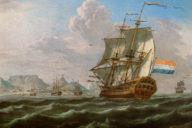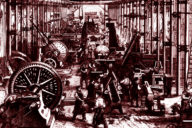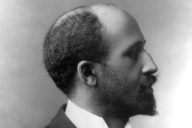Take my title as you would any of those route names in which there is a pun or double entendre that refers, at the same time, to some physical feature or characteristic of the rock, and to something about the experience, physical or mental, of climbing the route. “Thin Air,” a soaring climb all the way up Cathedral Ledge in New Hampshire, comes to mind. As do any number of routes in the Shawangunks named by the Vulgarians,[1] and by the rock climbers who followed them.[2] Of course, not all route names involve a play on words; there are the numerous routes named according to topography and points of the compass, and those named after their first ascensionists. When and where did the practice of names with a double entendre emerge? Are there places in the world where routes are not named in this way? Questions for the comparative philologist, which further research will have to answer.
When I searched Mountain Project I could not find any routes named “Climbing by the Book,” or even “By the Book.” There were, predictably, routes with names like “Open Book” and “The Good Book,” which seems to be common even outside of the Bible Belt when naming routes involving a dihedral. And, for those who climb in the Northeast, there was, of course, “The Book of Solemnity,” also at Cathedral Ledge.[3]
I think that there ought to be a route called “Climbing by the Book.” Why do I think so? Because, as climbers, we like to think that we climb by the book, in the sense that we take every possible precaution we can think of in a given situation to ensure our safety and that of our partner—even though we also know that, ultimately, doing so is no guarantee against the risk of injury or death. Learning, and adhering to, commonly accepted best practices—that is one sense of “climbing by the book.”
Another sense relates to reading. Books such as Into Thin Air and Touching the Void have captured the imagination of millions of readers, most of whom are not rock climbers or mountaineers—and probably would not want to take up these activities after reading Jon Krakauer or Joe Simpson’s tales of hubris, perfidy, and unlikely survival.[4] I am thinking less about such books, however, than about, how, for climbers who enjoy reading, or find that they can improve themselves and their climbing by doing as well as by reading, there are a plethora of manuals on climbing—from How to Rock Climb! to How to Climb 5.12![5]
Although I never have climbed 5.12, I have read these books and others. I have even gained insight from Heinrich von Kleist’s “Über das Marionettentheater,” an early nineteenth-century meditation on puppetry and dance.[6] But my first climbing book, in those innocent days when the only Seneca I had heard of was a Roman philosopher from early in the first millennium, was this author’s “On the Shortness of Life.” Long an avid hiker and backpacker, I had wanted to take up rock climbing because it seemed like a logical way to reach places in the mountains that would otherwise be inaccessible. It also looked like good fun. I did not know anybody who climbed, however, and, those days, New York City rock gyms were few, and forbidding to the uninitiated; in any case, rock climbing indoors seemed to me a contradiction in terms. So I signed up for instruction with Eastern Mountain Sports at their climbing school in the Gunks. This was in the summer of 2001, soon after submitting the manuscript of my first book to my publisher. I must have been searching for something else, other than a new way into the mountains. Why else would I have taken with me to Gardiner, NY, a volume of Seneca’s Moral Essays instead of some lighter reading?[7] I recall sitting, after a bruising but exhilarating day on toprope, on a boulder near the shore of Lake Minnewaska, reading Seneca’s challenge to ways of conducting one’s life that seemed to him to imply an assumption that life was infinitely long.
“You live as if you were destined to live forever,” Seneca chides Paulinus, the high official to whom “On the Shortness of Life” is addressed, “no thought of your frailty ever enters your head, of how much time has already gone by you take no heed. You squander time as if you drew from a full and abundant supply, though all the while that day which you bestow on some person or thing is perhaps your last.”[8] When I read this I was 33 years old; perhaps I felt that it was time for me to ask myself whether I held such notions. Other passages also made me stop to reflect: “It takes the whole of life to learn how to live, and—what will perhaps make you wonder more—it takes the whole of life to learn how to die.”[9] And, of course, there is the idea of “plan[ning] out every day as if it were [your] last,”[10] and, toward the end of Seneca’s essay, “[n]o one keeps death in view, no one refrains from far-reaching hopes.”[11] I reread Seneca’s essay now, in the same Loeb text, and I notice a governing opposition between negotio and otium, translated respectively as “business” and “leisure,” with the latter negated in the former. Seneca abhors the negation, and writes: “Of all men they alone are at leisure who take time for philosophy, they alone really live” (Soli omnium otiosi sunt qui sapientiae vacant, soli vivunt).[12] I do not know Latin, and cannot engage with Seneca as a specialist. This means that, although I see a path of reading that would open up otium for further reflection, I am guided by Seneca as I was when I first read him, solely for inspiration.
People climb for different reasons. I could tell a different story to the one I am telling now, relating to psychoanalytic theorist Melanie Klein, whom I was reading shortly before I picked up the phone to call EMS; then I would have to talk about the death of my father the previous summer, mourning, and the unconscious dynamics of reparation (Wiedergutmachung),[13] and what they might have to do with the activity of climbing. But that would take me from reasons into motivations.[14] For today, at least, let me stick to reasons. So why do people climb? Perhaps, for some, it is because climbing brings one into proximity with one’s mortality at nearly every step—even if one is not constantly thinking about it, and cannot be. This is the paradox; what the organizers of the symposium at which I first presented these thoughts have called “progressively recursive and self-problematizing reflections upon its own nature and its relation to the greater movement of nature—life—of which it is part,”[15] are, but, strictly speaking, cannot be, part of climbing as a practice. Climbing is, of course, not the only sport or recreational activity to bring one into proximity with one’s mortality, but it is the one that I took up back in 2001, the one to which I saw a direct link in Seneca’s challenge.
The “life” in Seneca’s Latin is vita, which, my Greek-English lexicon informs me, is the Latin equivalent of the Greek bios, and not zoe, or animal life. Seneca appears to abide by this distinction, writing, for example, of those who have not lived but merely existed.[16]
You could say, perhaps, that in an epoch of biopolitics and biopower, in which we are reduced—if Foucault and Agamben are to be credited—in many respects, to factors in actuarial calculations involving who lives and who dies, what Foucault terms more precisely “making live” and “letting die,”[17] that rock climbing allows one to take one’s own life in one’s hands, or to entrust it to one’s climbing partner, in ways that, for the duration of a climb, allow one to elude reduction to “bare life,” or zoe.
Rock climbing could thus, in the realm of North American sport, be the counterpart to broadly counter-biopolitical movements of our time, such as #BlackLivesMatter, and various stands that have been taken vis-à-vis Obamacare. Was it this way for climbers and mountaineers of the twentieth century too? Let us cast our eyes back to the era that, in a response to the massification of humanity, also saw the rise of National Socialism, Stalinism, and forms of hyper-nationalism that mobilized mountaineering (and other sports with the risk of death) in ways that ultimately reinforced that massification—and, in the case of Nazism, took biopolitics to its genocidal extreme. This history, which the symposium organizers of this symposium may be alluding to when they write of the “historically problematic attachment of mountaineering to colonialism, nationalism, and androcentrism,”[18] would include the Eiger north-face first ascent of 1938, concerning which Heinrich Harrer’s classic, The White Spider, although it has much to say about Austro-German camaraderie, says nothing of planting the swastika pennant at the summit, of receiving Adolph Hitler’s congratulations,[19] or of Harrer’s own membership of the Austrian SS.[20] It would also include the sponsorship by the Nazis of a series of failed expeditions to Nanga Parbat in the western Himalayas, an endeavor that was part of a symbolic imperial rivalry with the British and French, who sought the summits of Everest and Annapurna during the same years.[21] Authorities on climbing literature confirm the historical accuracy of my surmise: climbing as counter-biopolitical, but a pseudo-Nietzschean aristocratism complicit, under certain circumstances, with extreme forms of biopolitics.[22]
It is unnecessary for me to elaborate on this dark surmise when others have done so in minute detail. So let me return to some of the themes I pursued before I went there. In short, I was suggesting that climbing by the book is both necessary and impossible—not simply because, although a climber thinks and reasons, she cannot be thinking and reasoning at the moment she moves through a crux, or because climbing cannot ever be without reason or motivation, even if fully accounting for it eludes us—a “wayward reflexivity,” to be sure, but also a limit to any reflexivity. And that is where the best of the best route names, with their double and even multiple entendres, oscillating between topography and biography, remind us of something: Is it the rock? Is it me? Let these questions be an approximation in words of something that is not easy to grasp.[23] The language of route naming can serve to designate a limit to the answering of such questions—a limit to “climbing by the book.”
What about my subtitle, “Seneca Rocks,” which I only added later? Climbers on the Eastern Seaboard will be familiar with this haunting formation in rural West Virginia—an outcropping of the same band of quartzite conglomerate rock that forms the Shawangunk mountain, but because of seismic variation, in contrast to the Gunks, presents the climber with vertical instead of horizontal cracks. If you have learned how to climb in the Gunks, you will have to learn again at Seneca.[24] Same rock, different formation. Seneca rewrites the book for you: Is it the rock? Is it me? Topography or biography? These rocks are a sign of conditions of possibility that antecede and exceed the climber.
Seneca Rocks: A cursory internet search tells me that the name comes from the nearby Seneca Creek, which got its name from being a place of settlement and passage of some of the earliest Americans;[25] the Seneca were, and are, one of the Six Nations.[26] Knowing this can prompt one to reflect—as upon Shawangunk, a name that comes from the Lenape language, as another internet search informs me.[27] Would it be an impiety to suggest that, as climbers make the steep approach up Seneca, we embrace not only the historical memory but also the sense of the double entendre that I can never stop hearing: Seneca Rocks, with “rocks” alternating between noun and verb? For it is philosophy—that vital and mortal reflexivity that came to me as a novice climber reading a book by a Roman philosopher—that brings into question what we do, even if, as we do it, we are, and must inevitably be, forgetful of the question—whether it be of our own mortality, or of the complicity, historical or political, of which the names that climbers choose are the traces.
***
[1] See Laura and Guy Waterman, Yankee Rock & Ice: A History of Climbing in the Northeastern United States (Mechanicsburg, PA: Stackpole Books, 1993), 158-60, 170-79.
[2] See Dick Williams, The Climber’s Guide to the Shawangunks: The Trapps, 2nd ed. (High Falls, NY: Vulgarian Press, 2001); The Climber’s Guide to the Shawangunks: The Near Trapps, Millbrook, 2nd ed. (High Falls, NY: Vulgarian Press, 2008).
[3] Mountain Project. https://www.mountainproject.com/.
[4] Jon Krakauer, Into Thin Air: A Personal Account of the Mount Everest Disaster (New York: Villard, 1997); Joe Simpson, Touching the Void (New York: Harper & Row, 1988).
[5] John Long, How to Rock Climb! (Evergreen, CO: Chockstone Press, 1989); Eric J. Hörst, How to Climb 5.12! (Evergreen, CO: Chockstone Press, 1997).
[6] Heinrich von Kleist, “The Puppet Theatre,” in Selected Writings, ed. and trans. David Constantine (London: J.M. Dent, 1997), 411-16.
[7] This is evidently a path well trodden. When, after an arduous ascent, Petrarch reached the top of Mont Ventoux on 26 April 1336, he opened at random Augustine’s Confessions, which he had been carrying with him. “Where I fixed my eyes first,” Petrarch relates, “it was written: ‘And men go to admire the high mountains, the vast floods of the sea, the huge streams of the rivers, the circumference of the ocean, and the revolutions of the stars—and desert themselves.’ I was stunned, I confess. I bade my brother, who wanted to hear more, not to molest me, and closed the book, angry with myself that I still admired earthly things.” This prompts Petrarch to recall Seneca: “Long since I ought to have learned, even from pagan philosophers, that ‘nothing is admirable besides the mind; compared to its greatness nothing is great’”; Petrarch, “The Ascent of Mont Ventoux,” in The Renaissance Philosophy of Man, ed. Ernst Cassirer, Paul Oskar Kristeller, and John Herman Randall, Jr. (Chicago: University of Chicago Press, 1948), 44. I thank Nicola Masciandaro for drawing my attention to this luminous text.
[8] Seneca, “On the Shortness of Life,” Moral Essays, vol. 2, trans. John W. Basore (Cambridge, MA: Harvard University Press, 1932), 295.
[9] Ibid., 305.
[10] Ibid., 309.
[11] Ibid., 355.
[12] Ibid., 332-33.
[13] Klein, Melanie, Love, Guilt and Reparation, and Other Works 1921-1945 (London: Hogarth Press, 1975).
[14] Mark Sanders, Learning Zulu: A Secret History of Language in South Africa (Princeton: Princeton University Press, 2016), 4.
[15] Note to symposium: Climbing: From Bios to Zoe and Beyond. Department of Performance Studies, Tisch School of the Arts, New York University, November 11, 2016. https://tisch.nyu.edu/performance-studies/events/climbing-from-bios-to-zoe-and-beyond. My thanks are due to Nicola Masciandaro, Margret Grebowicz, and Andre Lepecki, for inviting me to speak.
[16] Seneca, “On the Shortness of Life,” 309.
[17] Michel Foucault, Society Must Be Defended: Lectures at the Collège de France, 1975-76, ed. Mauro Bertani and Alessandro Fontana, trans. David Macey (New York: Picador, 2003); Giorgio Agamben, Homo Sacer: Sovereign Power and Bare Life, trans. Daniel Heller-Roazen (Stanford: Stanford University Press, 1998).
[18] Note to symposium: Climbing: From Bios to Zoe and Beyond.
[19] See Rainer Amstädter, Der Alpinismus: Kultur—Organisation—Politik (Vienna: WUV-Universitäts-Verlag, 1996), 466-68.
[20] In The White Spider, Harrer was probably alluding to what was then publicly known about the climbers’ Nazi affiliations when he wrote that “As to the report that we climbed on the orders, or even at the wish, of some personage or other, it is absolutely off the mark. We followed the dictates of our will solely”; Heinrich Harrer, The White Spider: The Classic Account of the Ascent of the Eiger, trans. Hugh Merrick (New York: Jeremy P. Tarcher/ Putnam, 1998), 135. The White Spider was first published in 1958, whereas Harrer’s membership of the SS came to light in 1997, the year in which the film adaptation of his book, Seven Years in Tibet, was released; see Tilman Müller and Gerald Lehner, “Ein Held mit braunen Flecken,” Stern 23 (1997): 24-30.
[21] See Harald Höbusch, “Mountain of Destiny”: Nanga Parbat and Its Path Into the German Imagination (Rochester, NY: Camden House, 2016).
[22] The verdict of mountaineering historians is damning. According to Helmuth Zebhauser, who has written about the German and Austrian Alpine Association, “German and Austrian alpinism . . . ‘became entangled in the web of political constellations. Völkisch tendencies, grand airs of a master race, visions of a German empire, a racially pure Germanness, of Aryanism, and Heimat permeated society and were disseminated through literature, art, and clubs. The Alpine Association and its statutes came under the influence of anti-Semitism. Geopolitics was recruited for the purpose of imperialism. The competitive attitude of sport, the ideal of the close-knit group became intermixed with notions of trench comradeship and nationalistic revisionism’”; Helmuth Zebhauser, Alpinismus im Hitlerstaat: Gedanken, Erinnerungen, Dokumente (Munich: Bergverlag Rudolph Rother, 1998), 21; quoted in Höbusch, “Mountain of Destiny”, 30. And, according to Rainer Amstädter, “After 1918, German nationalist, anti-socialist, and anti-Semitic tendencies within the bourgeois alpine associations actively support the rise of National Socialism”; Amstädter, Alpinismus, 17; quoted in Höbusch, “Mountain of Destiny”, 31. For details about the Gleichschaltung of the Alpine Association, see Höbusch, “Mountain of Destiny”, 31-36. For another recent account of the entanglements with Nazism of the Alpine Association, see Tait Keller, Apostles of the Alps: Mountaineering and Nation Building in Germany and Austria, 1860-1939 (Chapel Hill, NC: University of North Carolina Press, 2016), 183-212. Keller notes that, in the Weimar area, the Alps offered a refuge to “mass man,” becoming a destination for a burgeoning mass tourism. This, in turn, brought about an elite response that took a politically reactionary form; Keller, Apostles of the Alps, 181-82.
[23] Entering into questions of time, Sanford Kwinter’s brief but illuminating thoughts on rock climbing offer a different vocabulary: “no climber could afford a strategic command center that programmed the body to behave globally in response to fixed or, god forbid, average conditions. Every square centimeter represents its own interdependent dynamical system continuously cross-referencing with the others, but locally in relation to its own ‘micro-site-specificity.’ Yet it is the mountainface itself whose flow is the most complex, the most intractable and problematic of all. The mineral shelf represents a flow whose timescale is nearly unfathomable from the scale of duration represented by the electrolytic and metabolic processes of muscle and nerves—but even at this timescale—nanometric in relation to the millennia that measure geological flows—singularities abound”; Sanford Kwinter, Architectures of Time: Toward a Theory of the Event in Modernist Culture (Cambridge, MA: MIT Press, 2001), 30-31.
[24] For awakening me to this fact, I am grateful to Beth McLendon, Elaine Matthews, and Pauline Eng, with whom Louise Kuhn and I spent two memorable days climbing at Seneca Rocks the Memorial Day weekend of 2012.
[25] Monongahela National Forest: Seneca Rocks: Overview/Background, www.fs.usda.gov/generalinfo/mnf/recreation/generalinfo/?groupid=9521&recid=7051.
[26] Seneca Nation of Indians, https://sni.org/.
[27] Shawangunk Ridge, https://en.wikipedia.org/wiki/Shawangunk_Ridge.







1 Comment
[…] Mark Sanders, “Climbing by the Book; Or, Seneca Rocks,” Politics / Letters 12 (2018). […]